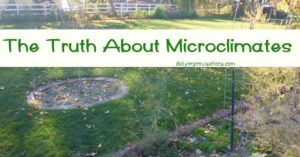What is a microclimate?
If you want to utilize microclimates, you need to understand
- the variables they are defined by and
- the limits they have under the broader regional climate.
In essence, the word microclimates needs to be recognized not so much as “small pockets of different climate” within a regional climate, but as
small variations in the context of the basic regional climate.
In a nutshell, there is nothing you can do to make a zone 5 climate have consistent outdoor zone 7 climate characteristics.
What affects a microclimate?
There are still ways to use the notion of microclimates in your garden and landscape, but you will benefit from considering it from all angles. For instance, the area that gets some nice afternoon shade may be great for preserving annual flowers from the heat during the summer, but it will also be one of the coldest during the winter, not to mention one of the last to warm up in the spring. This can be hard on some shrubs.
A microclimate can be affected by several factors:
- overall sunlight
- protection from wind
- proximity to heated structures
- type of soil
- slope of ground
There can be obvious and subtle differences in each of these factors that can make a difference in how things grow there.
Overall sunlight
The total amount of direct sunlight makes a big difference to most plants, but not all sunlight is equal. Sunlight in the morning tends to be cooler, simply because the outside temperature is cooler. Direct overhead sunlight gives the most light benefit. It can also matter from what angle the sunlight is hitting.
This year I grew some bell peppers that were moderately shaded on the south side by some bush beans. The peppers still got a lot of overhead sunlight, as well as on the north side of the plants. However, having the bean plants there proved to be just enough to keep me from having the normal problem of sun scald on my peppers! This was an accidental microclimate that I am very happy to have discovered.
I have a garden on the west side of the house that gets nearly full sunlight for 6 hours (generally the recommended minimum) in the late afternoon. For some of the plants this is okay, but others are always spindly. Shade plants think it is too much sun, but sun lovers think it is not enough, so it can be tricky to find plants to look nice there. We are thinking of putting in a patio…
There can be unexpected factors in sunlight that affect how a spring or fall frost affect plants. In my experience, warm weather plants (pumpkins, beans, peppers) that have more full sun during the day and especially later in the day may make it through a light frost. Plants that are subject to cooling earlier in the evening or stay in the shade longer in the morning might not fare as well. Even cool weather crops (broccoli, lettuce) may produce longer into the fall if they stay a bit warmer.
Protection from the wind
In the spring, I watch with a mix of fear and fascination as my newly planted greenhouse seedlings dance or flail in the wind. It is a matter of perspective. In some ways, the smaller plants have an advantage in the wind, but it can also depend on where in the yard they reside. I know there is a certain path over the small rise at the back of my yard where the wind whips between the houses. In fact, we had a small tornado come through exactly there once.
Keep in mind that this is Idaho. We *don’t* have tornadoes in Idaho, but there are occasional small ones that rip through neighborhoods. That particular tornado took down a well established cedar tree next to the house and tore off our patio cover.
The rest of you may not have had quite the drama to help you discover your own yard’s wind tunnels, but structures and the lay of the land do affect how the wind blows. It is best to figure out where your prevailing winds usually come from and design your garden accordingly. This might mean choosing a different spot for your favorite apple tree or it might mean planting a wind break. Just keep in mind that the wind will go someplace and you may be creating other wind tunnels.
Proximity to heated structures
The house is the main heated structure in most yards, though in some cases there may be detached heated structures such as a garage, chicken coop, or workshop. Which side of the structure the plants are next to makes the most difference in the spring and fall, when a late or early light frost might kill plants out in the open.
The biggest down sides to this aren’t so much about the plants as the house. It is risky to water regularly next to the house. You risk seepage in or damage to outer parts.
There is also the issue of roots. Growing roots are strong and destructive. Just ask my asphalt driveway about the pine trees growing next to it; or my brickwork about the vining perennial clinging to it. By the way, that vine is coming down before any significant damage is done. Pipes and cement are also not immune to root strangulation or infiltration.
What is bad for the plants is that they are also usually protected from the eaves from normal precipitation. That means that you would have to remember to get out and water them even if the rest of the garden is being thoroughly drenched by rain.
The bottom line is that planting next to a structure may sound like a handy microenvironment, but it is fraught with pitfalls.
Type of soil
Not a lot of people talk about how soil can be a part of microclimates. It is pretty simple, though. How well the soil retains water, drains, or supports (both nutritionally and structurally) the plant make big difference in how wind and temperature will affect the plant.
I have mentioned in the past how the more composted soil of my raised beds does not freeze as soon or as hard other parts of my yard. There are also a couple of places where water pools in the front yard, which means that when things freeze, any plants are more prone to damage from the ice.
Slope of the ground
Which way does your garden slope? My backyard starts at the top of a small rise to the south and slopes gently away. This means a southern exposure with a slight buffer from wind and sunlight. It seems like the best of everything to me, but maybe it is wishful thinking. Anyway, it was poetic to describe, right?
It doesn’t slope enough to create issues with watering. However, I also don’t have trouble with water pooling where I don’t want it to. Also, the shade from trees and house probably have a larger impact on sunlight than the slope.
The greater the degree of slope, the more you will have to take it into account for how it affects everything. Constant erosion or water flow from gravity is going to affect any microclimates. A distinctly northern facing slope in a cooler climate could be frustrating.
Realistic expectations lead to more satisfaction
With some 30 years of gardening experience now, I don’t have quite as high of hopes for microclimates as I used to. Realistic evaluation of their potential means that I use my energy and resources in more effective and long lasting ways. I still have fun with microclimates and I still use them in the spring and fall, but I know that the extremes of winter and summer will not be moderated much, if any, by a microclimate. That’s okay. I have learned to enjoy what I can do in my climate.
Here is a short video summarizing microclimates while walking around my yard some:


Leave a Reply